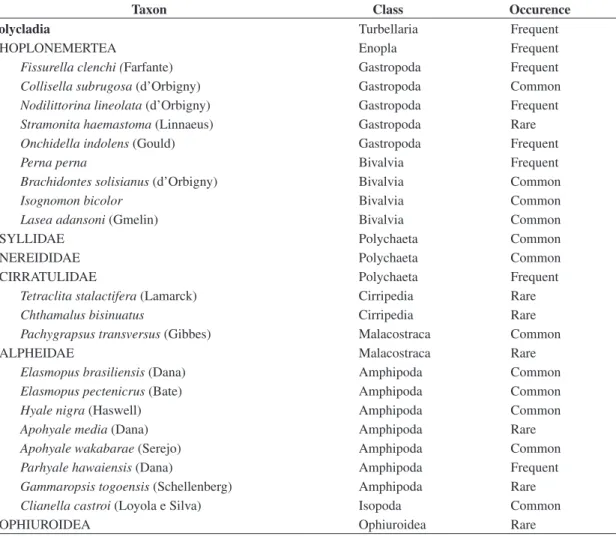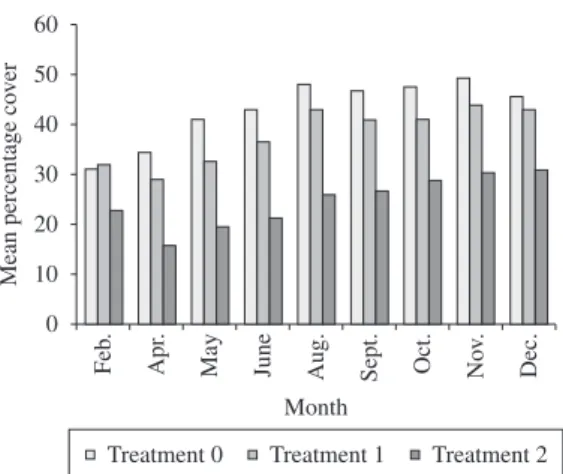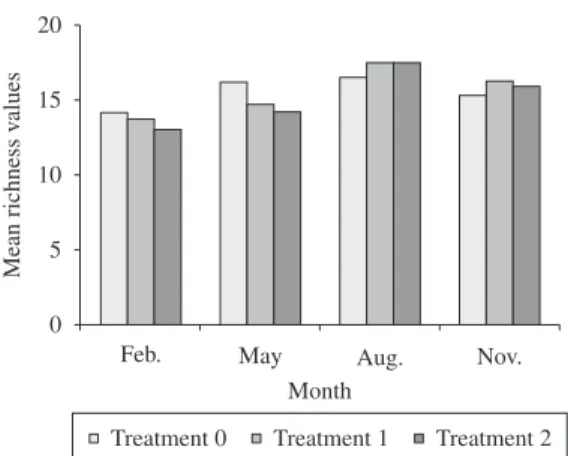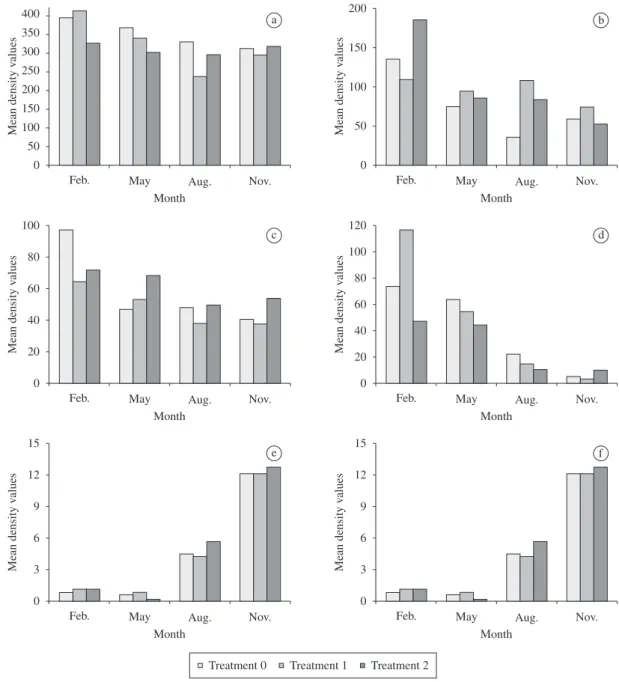on the Sao Paulo coast, southeastern Brazil
Ferreira, MN.* and Rosso, S.*
Departamento de Ecologia, Insituto de Biociências, Universidade de São Paulo – USP, Rua do Matão, Travessa 14, 321, CEP 05508-900, São Paulo, SP, Brazil
*e-mail: marinf@ib.usp.br, serrosso2@ib.usp.br
Received January 28, 2008 – Accepted June 25, 2008 – Distributed November 30, 2009 (With 6 figures)
Abstract
Increased tourist activity in coastal regions demands management strategies to reduce impacts on rocky shores. The highly populated coastal areas in southeastern Brazil are an example of degradation caused by development of indus-try and tourism. Among different shore impacts, trampling has been intensively studied, and may represent a signifi-cant source of stress for intertidal fauna. A randomised blocks design was applied to experimentally study the effects of two different trampling intensities on richness, diversity, density and biomass of the rocky shore fauna of Obuseiro beach, Guarujá, southeastern Brazil. Blocks were distributed in two portions of the intertidal zone, dominated respec-tively by Chthamalus bisinuatus (Cirripedia) and Isognomon bicolor (Bivalvia). Blocks were trampled over three months, simulating the vacation period in Brazil and were monitored for the following nine months. Results indicate that Chthamalus bisinuatus is vulnerable to trampling impacts. Richness, diversity and turn-over index tended to be higher in trampled plots four months after trampling ceased. In general, results agree with previous trampling studies, suggesting that even low intensities of trampling may cause some impact on intertidal communities. Management strategies should include isolation of sensitive areas, construction of boardwalks, visitor education and monitoring programmes. In Brazil, additional data obtained from experimental studies are necessary in order to achieve a better understanding of trampling impacts on rocky shore communities.
Keywords: rocky shore, intertidal community, trampling, tourism impacts.
Impactos do pisoteio humano na fauna de um costão rochoso
do litoral de São Paulo, no sudeste brasileiro
Resumo
O aumento da atividade turística em áreas costeiras nas últimas décadas faz necessária a adoção de estratégias de manejo para reduzir os impactos gerados às comunidades de costões rochosos. A região costeira do sudeste brasileiro possui bons exemplos de degradação causada pelo turismo e desenvolvimento industrial. Dentre os diferentes distúr-bios causados pela visitação, o pisoteio têm sido estudado de forma intensa e pode representar uma fonte significativa de impactos para as comunidades da zona entre-marés. Neste projeto, foi aplicado um desenho de blocos randômicos para se avaliar experimentalmente os efeitos de duas intensidades de pisoteio na riqueza, diversidade, densidade, reco-brimento e biomassa da fauna de um costão situado na praia do Obuseiro, no município do Guarujá, São Paulo, Brasil. Os blocos foram alocados em dois povoamentos diferentes, dominados respectivamente por Chthamalus bisinuatus (Cirripedia) e Isognomon bicolor (Bivalvia). O pisoteio foi aplicado durante três meses, simulando a temporada de férias no Brasil, e os blocos foram monitorados nos nove meses seguintes. Os resultados indicaram que Chthamalus bisinuatus é vulnerável aos impactos do pisoteio. Os índices de riqueza, diversidade e turnover apresentaram uma ten-dência ao aumento nas áreas pisoteadas quatro meses após o término do pisoteio. No geral, os resultados concordam com estudos anteriores e sugerem que mesmo baixas intensidades do distúrbio podem causar impacto às comunidades bentônicas. Estratégias de manejo devem envolver o isolamento de áreas sensíveis, a construção de passarelas, a edu-cação dos visitantes e o monitoramento das comunidades impactadas. No Brasil, a realização de maior quantidade de estudos experimentais é necessária para a melhor compreensão dos impactos do pisoteio nas comunidades de costões rochosos.
located on the central coast of São Paulo state, in south-eastern Brazil. Obuseiro beach is situated within the limits of a military area (“1o Batalhão de Artilharia
Anti-Aérea do Forte dos Andradas”, Brazilian Army), and the access to the beach is granted only to some local fisher-men.
The study site consists of a gently sloping large gran-ite rock, dominated by Chthamalus bisinuatus on the upper-shore and Isognomon bicolor on the mid-shore.
2.2. Experimental design
Ten randomised blocks were equally distributed in two portions of the intertidal zone, dominated respec-tively by Chthamalus bisinuatus and Isognomon bicolor. Both species were selected for this study since they are conspicuous, perennial and widely distributed on rocky shores in southeastern Brazil. I. bicolor is an exotic spe-cies that has been recorded on Brazilian rocky shores for the last ten years, especially in the zone originally oc-cupied by the mussel Perna perna (Linnaeus) that has been over-exploited as a food resource in many areas (Martins, 2000).
Blocks were trampled in a single day over three months, simulating the summer vacation period in Brazil, and were monitored for the following nine months. Data collection was always performed before trampling, so data from the first month relates to community condi-tions before trampling impacts.
Each block consisted of three experimental units (EU), 4,900 cm2 each, separated by a 20 cm stripe. In
each block, different trampling intensities were applied in the EUs, as follows: treatment 0 (no trampling, con-trol units); treatment 1 (50 steps per month); treatment 2 (250 steps per month). Since the steps were applied randomly in a 4,900 cm2 area and foot size was 200 cm2,
it can be considered that on average each portion of EUs was trampled two times in treatment 1 and ten times in treatment 2. Trampling was performed by a 56 kg person using rubber-soled shoes.
An area of 900 cm2 within the EU was selected for
data collection. The position of this area and the treat-ment applied in each EU was randomly determined. The remaining portion of the EU in the I. bicolor assemblage blocks was used to perform total removals of individuals present in 100 cm2, every 3 months during one year.
These samples were washed in a 0.5 mm mesh (GRANUTEST) in order to select macrofaunal organ-isms only. All organorgan-isms were counted after identifica-tion to species level, with the excepidentifica-tion of Ophiuroidea, Turbellaria, Nemertea and Polychaeta which were iden-tified to higher taxonomic levels.
Different variables were analysed, according to as-semblage characteristics. Variables and their collection methods are presented as follows:
i) Cover of C. bisinuatus: cover estimates were monthly obtained through photographs taken from nine squares of 100 cm2 for each EU.
Photographs were scanned and C. bisinuatus
1. Introduction
Rocky shores are subject to increasing anthropogen-ic impacts originating from both the land and the sea. These habitats have been, and are currently, affected by pollution, over-collection of living resources, introduc-tion of alien species, modificaintroduc-tion of coastal processes and global changes (Thompson et al., 2002).
Increased tourist activity may also represent a significant source of impact to rocky shore communities. The effects of human trampling on intertidal fauna have been intensively studied, especially in temperate zones (Povey and Keough, 1991; Brosnan and Crumrine, 1994; Fletcher and Frid, 1996; Keough and Quinn, 1998; Schiel and Taylor, 1999). Most studies have observed a reduction in abundance of some taxa, such as polychaetes (Brown and Taylor, 1999), bivalves (Beauchamp and Gowing, 1982) and barnacles (Brosnan and Crumrine, 1994) that may affect population dynamics and diversity of the entire community.
Different species of non-crustose algae were also vulnerable to trampling, showing reduction in values of abundance, cover and biomass (Povey and Keough, 1991; Fletcher and Frid, 1996; Keough and Quinn, 1998; Schiel and Taylor, 1999). Some groups, such as limpets and crustose algae, indirectly benefited from trampling, usu-ally occupying empty areas created after the displacement of conspicuous species (Keough and Quinn, 1998).
Few studies have been developed on barnacle and bivalve assemblages, even though organisms in these groups are considered vulnerable to trampling, since they are small, sessile and easily squashed (Povey and Keough, 1991). Previous research has mostly focused on large conspicuous organisms, even though smaller cryptic animals also deserve attention due to their great abundance, high productivity and importance as food for higher trophic levels (Brown and Taylor, 1999).
The presence of beaches and other natural resourc-es on practically the whole Brazilian coast attracts large number of tourists, especially at vacation periods and close to major cities, such as Sao Paulo. Guaruja municipality, for instance, has a population close to 230,000 people and receives more than 150,000 tourists during the summer season (IBGE, 2002).
The highly populated coastal areas in Brazil are an example of degradation caused by development of in-dustry and tourism with several environmental impacts on coastal communities. However, the effects of human trampling on Brazilian rocky shores have not been pre-viously examined. Therefore, this study aimed to inves-tigate the effects of trampling on communities associ-ated to Chthamalus bisinuatus Pilsbry (Cirripedia) and Isognomon bicolor (Adams) (Bivalvia) from a rocky shore in southeastern Brazil.
2. Material and Methods
2.1. Study site
was applied in its exponential form (2H’ – Shannon
apparent richness) which represents a good alternative to H’ and allows direct comparisons to absolute values of richness.
v) Turnover index of the community associated with I. bicolor: this index represents the sum of community losses and gains over time (Giordano, 2001) and it is calculated with the following formula:
T = L/ STn + G/ STn+1 (1)
where:
L = number of taxons present in Tn and absent in Tn+1 (lost taxons)
G = number of taxons absent in Tn and present in Tn+1 (gained taxons)
STn = number of taxons in Tn time STn+1 = number of taxons in Tn+1 time
As the sum of two fractions, the turnover index can vary from zero to two, where zero represents cover percentage was measured in a central
area of 25 cm2, using the software ArcView
GIS 3.2 (ESRI, 1999). Therefore, for each EU, C. bisinuatus cover was estimated from a total area of 225 cm2 (nine squares of 25 cm2).
ii) Cover of I. bicolor: cover estimates were obtained monthly through the division of the 900 cm2 area
in 225 small squares of 4 cm2. Each square was
classified from zero to two (zero representing none to 35% cover of I. bicolor, one representing 36 to 70% cover and 2 representing more than 70% cover of I. bicolor). The sum of these classes (that could vary from 0 to 450) was then transformed into a percentage value that indicated the cover percentage of I. bicolor in each EU. iii) Richness of the community associated with
I. bicolor: richness was calculated for each sample (100 cm2), based on the number of taxons (mostly
species) present in the sample.
iv) Diversity of the community associated with I. bicolor: Shannon-Wiener diversity index (H’)
Table 1. Invertebrate intertidal fauna from a rocky shore in Obuseiro beach, SP, Brazil. Common taxa occured in more than 40 samples, frequent taxa occurred in 20 to 39 samples, and rare taxa occurred in less than 20 samples (total: 60 samples).
Taxon Class Occurence
Polycladia Turbellaria Frequent
HOPLONEMERTEA Enopla Frequent
Fissurella clenchi (Farfante) Gastropoda Frequent
Collisella subrugosa (d’Orbigny) Gastropoda Common
Nodilittorina lineolata (d’Orbigny) Gastropoda Frequent
Stramonita haemastoma (Linnaeus) Gastropoda Rare
Onchidella indolens (Gould) Gastropoda Frequent
Perna perna Bivalvia Frequent
Brachidontes solisianus (d’Orbigny) Bivalvia Common
Isognomon bicolor Bivalvia Common
Lasea adansoni (Gmelin) Bivalvia Common
SYLLIDAE Polychaeta Common
NEREIDIDAE Polychaeta Common
CIRRATULIDAE Polychaeta Frequent
Tetraclita stalactifera (Lamarck) Cirripedia Rare
Chthamalus bisinuatus Cirripedia Rare
Pachygrapsus transversus (Gibbes) Malacostraca Common
ALPHEIDAE Malacostraca Rare
Elasmopus brasiliensis (Dana) Amphipoda Common
Elasmopus pectenicrus (Bate) Amphipoda Common
Hyale nigra (Haswell) Amphipoda Common
Apohyale media (Dana) Amphipoda Rare
Apohyale wakabarae (Serejo) Amphipoda Common
Parhyale hawaiensis (Dana) Amphipoda Frequent
Gammaropsis togoensis (Schellenberg) Amphipoda Rare
Clianella castroi (Loyola e Silva) Isopoda Common
Recovery to original values of differences among treat-ments (Kruskal-Wallis test; february; p = 0.0493) was not observed even seven months after trampling ceased (Kruskal-Wallis test; November; p = 0.004). Repeated measures analysis also indicated that trampling promot-ed different patterns among treatments (Table 2), but the Tukey HSD test indicated significant differences only between treatments 0 and 2 (Tukey test; p = 0.0003).
Cover values of I. bicolor were usually high, rang-ing from 75 to 90% (Figure 2) and were not affected by trampling. However, mean values of percentages de-creased with time in all treatments.
Mean richness values of the community associated to I. bicolor ranged from 13 to 18 taxa (Figure 3), while diversity values ranged from 4.5 to 5.8 (Figure 4). Both variables showed similar patterns four months after trampling ceased, with mean values for treatments 1 and 2 significantly higher when compared to original values (Table 3).
For all treatments, the turnover index values declined with time, changing from an initial pattern of gaining species (turnover positive values) to a pattern of losing species (turnover negative values). It is worth noting that while turnover values for treatment 0 were gradu-ally reduced, treatments 1 and 2 values rose from May to August (Figure 5).
Density values varied widely among taxa, ranging from 0.2 to 413 indiviuals/100 cm2. Highest values of
the persistence of the same taxa in the community, while two represents the complete substitution of community taxa over time.
To better express the index descriptive value, a negative sign was attributed to the numeric value when the relative loss (L/STn) surpassed the relative gain (G/STn+1).
vi) Density of the macrofauna associated with I. bicolor: taxon density (number of individuals of the taxon/100 cm2) was calculated for each
collected sample.
2.3. Analyses
Considering the small numbers of replicates for each assemblage (n = 5), non-parametric tests were adopted in data analysis. Kruskal-Wallis and Mann-Whitney tests were used in order to identify significant differences be-tween treatments.
Cover data from C. bisinuatus and I. bicolor fol-lowed repeated measures design and were analysed by a method proposed by Gurevitch and Chester Jr. (1986). The remaining variables were taken from independent samples collected every three months, and therefore could not be classified as repeated measures data.
Density values were analysed for each taxon sepa-rately, but only results that indicate some pattern are pre-sented herein.
All data analysis was performed using STATISTICA 6.0 (StatSoft Inc., 2003), SPSS 12.0 (SPSS Inc., 2003) and MVSP 3.12a (KCS, 2000).
3. Results
Twenty-seven animal taxa were recorded in the studied assemblages (Table 1). Mean percentage cover of C. bisinuatus ranged from 15 to 50%. Trampling ef-fects in C. bisinuatus cover were observed after the third month of trampling, especially for treatment 2 (Figure 1).
Table 2. Repeated-measures analysis for C. bisinuatus cover.
Total df MS F p
Treatment 2 30030.6 22,2970 0.000091
Error 12 8081.1 -
-Total 14 - -
-Figure 1. Mean cover percentage of C. bisinuatus over time at all trampling intensities observed at Obuseiro rocky shore, São Paulo, Brazil.
density were presented by I. bicolor, indicating once again its dominance in the assemblage.
Trampling did not affect density values, that varied differently among taxa, but not among treatments. In gen-eral, three different patterns were observed: i) density re-duction over time, presented by I. bicolor, Brachidontes solisianus, Lasea adansoni and Hyale nigra; ii) density increase over time, presented by Collisella subrugosa; and iii) constant values of density over time, presented by Syllidae polychaetes (Figure 6).
4. Discussion and Conclusions
Several studies indicated that invertebrate fauna as-sociated with mussel communities may harbour from 32 to 99 species (Seed, 1996). However, in these studies all taxa were identified to species level, which may be responsible for the higher values found when compared to the I. bicolor community in this study (27 taxa). The structure of the bed may also interfere in these values, since mussel species usually form beds with several lay-ers of individuals (Seed, 1996), increasing attachment and colonization surface for associated species while the I. bicolor bed is constituted by a single layer.
Trampling impacts on C. bisinuatus cover may be related to low resistance of individuals to direct effects of trampling. Chthamalus species were also affected by trampling on rocky shores in the United States, Australia and United Kingdom (Povey and Keough, 1991; Brosnan and Crumrine, 1994; Pinn and Rodgers, 2005), suggest-ing that morphological, physiological or reproductive aspects of the group may be responsible for its high vul-nerability to trampling. Moreover, low cover values and indirect effects, such as limpets pasture could have also prevented C. bisinuatus recovery after trampling.
Resistance of I. bicolor to trampling may be ex-plained by its high values of density and also by aspects, such as accommodation and lateral movement, that cor-respond to rapid colonization of small patches by adult individuals (Connell and Keough, 1985).
Increase in richness and diversity values after tram-pling have already been observed in previous studies Figure 3. Mean values of richness of the community
as-sociated with I. bicolor over time at all trampling intensities observed at Obuseiro rocky shore, São Paulo, Brazil.
Figure 4. Mean values of diversity of the community as-sociated with I. bicolor over time at all trampling intensities observed at Obuseiro rocky shore, São Paulo, Brazil.
Figure 5. Mean turnover values of the community associ-ated with I. bicolor over time at all trampling intensities ob-served at Obuseiro rocky shore, São Paulo, Brazil.
Table 3. Mann-whitney test results for richness and di-versity values of the community associated with I. bicolor (p < 0.05)
Mann-Whitney (p)
Richness 0 1 2
Feb × May 0.2101 0.4034 0.4034
Feb × Aug 0.0947 0.0163 0.009
Feb × Nov 0.5309 0.0601 0.0601
Diversity 0 1 2
Feb × May 0.0163 0.1172 0.1172
Feb × Aug 0.1745 0.0283 0.0283
cating an increase in species gain tax for trampled plots until four months after trampling ceased.
It is well established that trampling may indirectly in-crease abundances of a range of common herbivores, as a result of cover reduction of dominant species (Povey and Keough, 1991; Keough and Quinn, 1998). In the present study, the decrease in I. bicolor cover percentage over time may be responsible for the increase in C. subrugosa densities, even though none of these processes were re-lated to trampling impacts. During grazing, herbivores usually dislodge barnacle young recruits, reducing their especially for intermediate levels of trampling (Liddle,
1975; Beauchamp and Gowing, 1982).
This pattern follows the disturbance hypothesis pro-posed by Connell (1978), in which intermediate level perturbations may interfere in the competitive exclusion process, changing community structure and favouring the occurrence of new stages on patch succession. This process allows the colonization of species rare or absent from well-established communities, consequently en-hancing richness and diversity values. The analysis of the turnover index corroborates this hypothesis, by
indi-a b
c d
e f
CONNELL, JH., 1978. Diversity in tropical rain forests and coral reefs. Science, vol. 199, no. 4335, p. 1302-1310.
CONNELL, JH. and KEOUGH, MJ., 1985. Disturbance and patch dynamics of subtidal marine animals on hard substrata. In PICKETT, STA. and WHITE, PS. (Eds.). The ecology of natural disturbance and patch dynamics. New York: Academic Press.
DAYTON, PK., 1971. Competition, disturbance and community organization: the provision and subsequent utilization of space in a rocky intertidal community. Ecological Monographs, vol. 41, no. 4, p. 351-389.
Environmental Systems Research Institute - ESRI, 1999. ArcView GIS 3.2. Available from: <http://www.esri.com>. Access in: 15 de Maio de 2004.
FLETCHER, H. and FRID, CLJ., 1996. Impact and management of visitor pressure on rocky intertidal algal communities. Aquatic Conservation: Marine and Freshwater Ecosystems, vol. 6, no. 4, p. 287-297.
GIORDANO, F., 2001. Colonização de placas de fouling no estuário de Santos (Santos-SP): análises transicional e de sensibilidade complementando a abordagem baseada em recobrimentos específicos e diversidade. São Paulo: University of Sao Paulo. Tese de Doutorado.
GUREVITCH, J. and CHESTER Jr., ST., 1986. Analysis of repeated measures experiments. Ecology, vol. 67, no. 1, p. 251-255. Kovach Computing Services - KCS, 2000. MVSP – Multivariate Statistical Package 3.12a. Available from: <http://kovcomp.co.uk>. Access in: 01 de Maio de 2004.
KEOUGH, MJ. and QUINN, GP., 1998. Effects of periodic disturbances from trampling on rocky intertidal algal beds.
Ecological Applications, vol. 8, no. 1, p. 141-161.
LIDDLE, MJ., 1975. A selective review of the ecological effects of human trampling on natural ecosystems. Biological Conservation, vol. 7, no. 1, p. 17-36.
MARTINS, CM., 2000. Isognomon bicolor (C.B. Adams 1845) (Bivalvia: Isognomonidae): ocorrência nova, redescrição e anatomia descritiva e funcional. São Paulo: University of Sao Paulo. Tese de Doutorado.
PINN, EH. and RODGERS, M., 2005. The influence of visitors on intertidal biodiversity. Journal of the Marine Biological Association of the United Kingdom, vol. 85, no. 2, p. 263-268.
POVEY, A. and KEOUGH, MJ., 1991. Effects of trampling on plant and animal populations on rocky shores. Oikos, vol. 61, no. 3, p. 355-368.
SAFRIEL, UN., EREZ, N. and KEASAR, T., 1994. How do limpets maintain barnacle-free submerged artificial surfaces? Bulletin of Marine Science, vol. 54, no. 1, p. 17-23.
SCHIEL, DR. and TAYLOR, DI., 1999. Effects of trampling on a rocky intertidal algal assemblage in southern New Zealand. Journal of Experimental Marine Biology and Ecology, vol. 235, no. 2, p. 213-235.
SEED, R., 1996. Patterns of biodiversity in the macro-invertebrate fauna associated with mussel patches on rocky shores. Journal of the Marine Biological Association of the United Kingdom, vol. 76, no. 1, p. 203-210.
SPSS INC., 2003. SPSS 12.0 for Windows. Available from: <http:// www.spss.com>. Access in: 01 de Maio de 2004.
STATSOFT INC., 2003. Statistica 6.1. Available from: <http://www.statsoft.com>. Access in: 13 de Junho de 2004.
THOMPSON, RC., CROWE, TP. and HAWKINS, SJ., 2002. Rocky intertidal communities: past environmental changes, present status and predictions for the next 25 years. Environmental Conservation, vol. 29, no. 2, p. 168-191.
survival rates and consequently affecting barnacle den-sity values (Dayton, 1971; Safriel et al., 1994).
Recolonization of bare spaces in barnacle assem-blages depended mainly on planktonical larvae recruit-ment, in contrast to mussels and algae species that present lateral movements or vegetative growth. This may amplify the impacts of herbivore grazing on barna-cle populations.
In this study, although density increases of C. subrugosa were not related to trampling, higher levels of mollusk grazing may have been an important factor preventing recovery of C. bisinuatus populations after trampling.
Other patterns, such as those observed for H. nigra, L. adansoni and B. solisianus were probably related to the natural decrease of I. bicolor cover and density, since these species are strongly associated to the I. bicolor bed.
In general, results agree with previous trampling studies, suggesting that even low intensities of trampling may cause some impact on intertidal communities and recovery may take several years. In this study, effects of human trampling were mainly observed in C. bisinuatus population, that occur in the upper portion of the inter-tidal zone, remaining exposed to trampling during sev-eral hours. Moreover, C. bisinuatus recovery was not observed until the next vacation period (nine months af-ter trampling ceased), which suggests that impacts from several years may be accumulative in heavily trampled rocky shores.
Management strategies should include isolation of sensitive areas, construction of boardwalks, visitor edu-cation and monitoring programmes. In Brazil, additional data obtained from experimental studies are necessary in order to achieve a better understanding of trampling impacts on rocky shore communities, especially in the highly populated southeastern Brazilian shores.
Acknowledgements — We thank 1o Batalhão de Artilharia
Anti-Aérea do Forte dos Andradas (the Brazilian Army) for allowing access to Obuseiro beach. We also thank M.T.V. Berardo, S. Bueno, M. Nomura and C. Nogueira, who helped during different phases of the research. This study was supported by a fellowship from CAPES.
References
BEAUCHAMP, KA. and GOWING, MM., 1982. A quantitative assessment of human trampling effects on a rocky intertidal community. Marine Environmental Research, vol. 7, no. 4, p. 279-293.
BROSNAN, DB. and CRUMRINE, LL., 1994. Effects of human trampling on marine rocky shore communities. Journal of Experimental Marine Biologyand Ecology, vol. 177, no. 1, p. 79-97.



